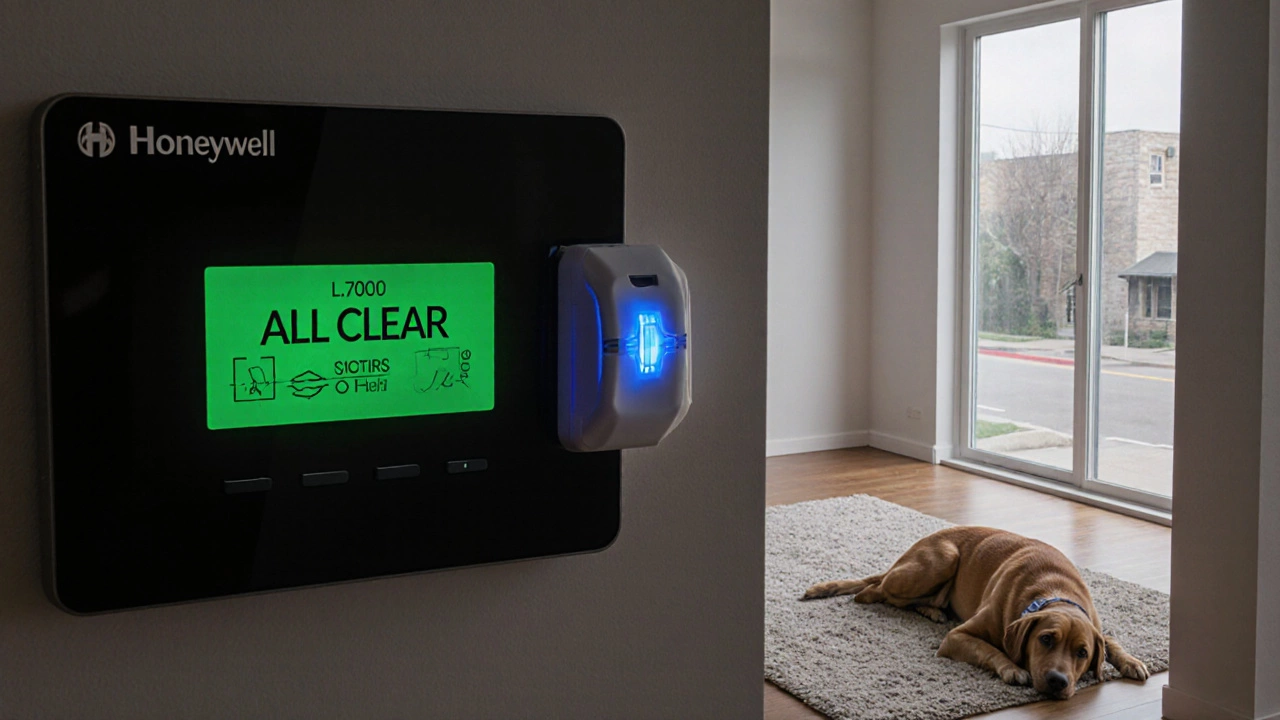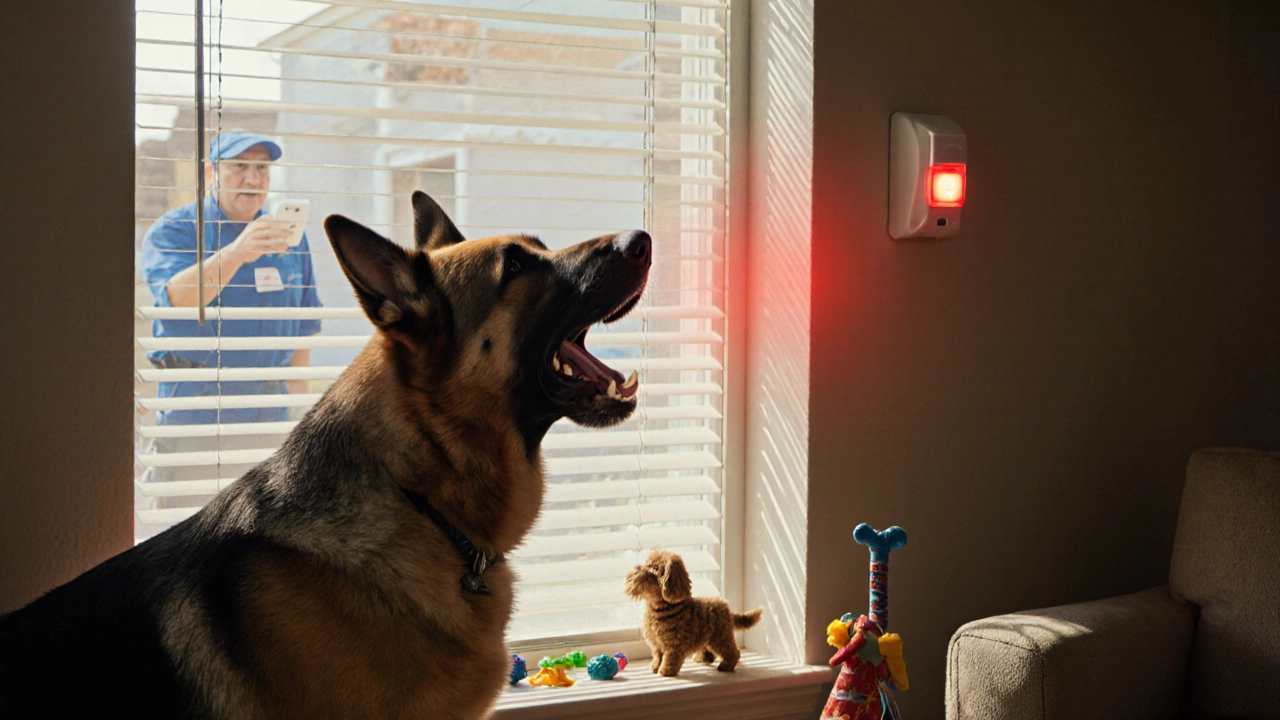Pet-Friendly Alarm Risk Calculator
Calculate Your False Alarm Risk
Enter your dog's details and alarm system type to see the probability of false alarms.
Ever had your dog bark at the mail carrier - only to hear your alarm system blare like a siren? You’re not alone. In fact, about 35-40% of pet-owning households with traditional alarm systems report false alarms triggered by their dogs. It’s not your dog being naughty. It’s the system not knowing the difference between a threat and a tail wag.
Why Dogs Trigger Old-Style Alarms
Traditional alarm systems were built in the 1960s - long before most people considered pets part of home security. These systems rely on two main sensors: motion detectors and sound sensors. Both are designed to catch humans, not huskies.Sound sensors are tuned to pick up loud, sharp noises - like breaking glass - which typically fall between 85 and 110 decibels. That’s exactly where most medium-to-large dogs sit. A German Shepherd’s bark? Around 95-100 decibels. A Boxer? Same range. Glass-break sensors don’t care if it’s a window shattering or your dog yelling at the neighbor’s cat. They just hear a spike in volume.
Motion detectors are just as problematic. Older passive infrared (PIR) sensors detect heat and movement in a wide cone - usually 15 to 30 feet out and 90 to 110 degrees wide. A 50-pound dog walking across the living room looks like a person to these sensors. Even worse, if your dog jumps on the couch or runs past the sensor, it’s game over. The system doesn’t know it’s your pet. It just sees movement and heat.
Pet-Friendly Alarms: How They Work
Around 2005, security companies started building systems that could tell the difference between a human and a dog. Today, nearly 78% of new home alarm installations in the U.S. and U.K. include pet-immune tech. These aren’t just gimmicks - they’re engineered solutions.Modern pet-friendly motion sensors use dual-technology detection: infrared heat + microwave radar. But here’s the key - they’re programmed to ignore heat signatures below 4 to 5 feet off the ground. That means your 40-pound Labrador? Invisible. Your 100-pound Great Dane? Still a problem, but better than before.
Sonar-based systems have gotten smarter too. Instead of just measuring volume, they analyze frequency and rhythm. A dog’s bark has a distinct pattern - usually 3 to 5 quick barks in a row, with frequencies between 200Hz and 20kHz. Human screams? Irregular, lower frequency, and often longer. Systems like the Honeywell SiXPIR filter out sounds that match dog vocalizations, while still catching a burglar yelling for help.
Even glass-break sensors have evolved. Old ones listened for one frequency - the high-pitched shatter. New ones need to hear two sounds at once: the low ‘thud’ (500-1,000Hz) of something hitting glass, and the high ‘shatter’ (8,000-10,000Hz). Dog barks don’t produce both. So even if your dog’s bark is loud enough, the sensor ignores it.

Real-World Performance: What Works and What Doesn’t
Not all pet-friendly systems are created equal. A 2023 Consumer Reports study found that professional-grade systems like the Honeywell L7000 achieved 97% accuracy in ignoring pets. But budget DIY kits? Not so much. SimpliSafe, despite marketing itself as pet-friendly, still triggered false alarms in 22% of installations with medium to large dogs.Ring Alarm Pro’s 3D Pet Immunity tech is one of the most reliable. In a 2023 survey, 89% of dog owners reported zero false alarms over six months - as long as sensors were mounted correctly. That’s a huge jump from the 63% of users with older systems who got 3+ false alarms per month.
But even the best systems have limits. A Great Dane’s deep, low-frequency bark - around 75Hz - can mimic the ‘thud’ of breaking glass. Consumer Reports documented one case where a Honeywell system triggered despite pet immunity settings. Same goes for Siberian Huskies. Their howls can hit frequencies that overlap with human cries. And if you have multiple dogs? Their overlapping barks can confuse even advanced AI filters.
Installation Tips to Avoid False Alarms
Buying a pet-friendly alarm isn’t enough. Where you place it matters just as much.- Mount motion sensors at 7 to 8 feet high - not the standard 6 feet. That puts them above most dogs’ heads.
- Avoid pointing sensors toward pet beds, food bowls, or favorite jumping spots. Dogs love to lounge on the couch - if your sensor is facing it, you’re asking for trouble.
- Use contact sensors on doors and windows instead of motion detectors in high-traffic areas. This cuts pet-related false alarms by 76%, according to Security Sales & Integration.
- Give AI-powered systems like Honeywell’s AI-PetSense a 7-day learning period. It watches your dog’s habits and adjusts sensitivity automatically.
- If you have a large breed (over 80 pounds), look for systems certified for up to 100-pound pets. The DSC GS2120-4PIR is rated for this and has a 4.7/5 star rating from pet owners.

What to Look for When Buying
Not every “pet-friendly” label means the same thing. Here’s what to check before you buy:- Weight limit: Does it support your dog’s size? Most systems work for pets under 40 pounds. Premium ones go up to 80 or even 100 pounds.
- Technology type: Dual-technology (PIR + microwave) is better than single-sensor models.
- Sound filtering: Look for systems that analyze frequency and rhythm - not just volume.
- Certifications: UL 2610 certification means the system has been tested to ignore pets up to 100 pounds in controlled environments.
- Professional vs. DIY: Professional systems (ADT, Vivint, Brinks) have better calibration tools and installers who know how to position sensors for pets. DIY systems like Ring or SimpliSafe require more trial and error.
Expect to pay 15-20% more for pet-immune systems. A basic alarm setup might start at $749. With pet immunity? Around $899 or more. But think of it this way: each false alarm costs you time, stress, and possibly a fine from your local police department.
The Future of Pet-Proof Security
The next wave of alarm tech is already here. Honeywell’s AI-PetSense learns your dog’s movement patterns over a week. By 2025, multi-spectral sensors combining thermal imaging, motion, and sound analysis will become standard. These systems won’t just ignore pets - they’ll recognize them by shape, heat signature, and even gait.But here’s the catch: open-plan homes with hardwood floors and high ceilings create echo chambers. Sound bounces. A bark that’s quiet in one corner might hit the sensor at full volume from another angle. That’s why even the best systems aren’t 100% foolproof.
Still, the trend is clear. With 66% of American households owning pets, security companies have no choice but to adapt. The pet-friendly security market is growing at 12.3% yearly - faster than the overall home security industry. By 2028, it’s projected to hit $8.2 billion.
If you have a dog and an alarm, you’re not stuck with false alarms. You just need the right system - and the right setup.
Can a small dog set off a home alarm?
Yes, but only if the system isn’t pet-friendly. Small dogs under 20 pounds are less likely to trigger motion sensors, but their barks can still set off sound detectors if the system isn’t designed to filter out dog vocalizations. Even a Chihuahua’s sharp bark can reach 90 decibels - loud enough to trigger an old-style alarm.
Do all pet-friendly alarms work for large dogs?
No. Many systems are only rated for pets up to 40 or 50 pounds. For dogs over 80 pounds - like Mastiffs or Great Danes - you need a system specifically designed for large breeds. Look for models with weight limits of 80-100 pounds and certified pet-immune glass-break sensors. Even then, deep, low-frequency barks can sometimes trigger false alarms.
Are DIY alarm systems reliable for pets?
Some are, but many aren’t. Brands like Ring and SimpliSafe offer pet-friendly features, but their accuracy varies. Consumer Reports found that 22% of SimpliSafe installations still trigger false alarms from pets. DIY systems require careful placement and often need adjustments after installation. Professional systems, with trained installers and better calibration, tend to perform more consistently.
Can I upgrade my old alarm to be pet-friendly?
Sometimes. If your system has replaceable sensors, you can swap out old motion detectors for pet-immune ones. But older control panels may not support newer technology. Check your manufacturer’s compatibility list. In many cases, it’s more cost-effective to replace the whole system - especially if it’s over 10 years old.
What’s the best alarm system for dogs?
For most dog owners, the Ring Alarm Pro with 3D Pet Immunity and the Honeywell L7000 are top choices. Ring works well for DIY users and has proven low false alarm rates in real-world tests. Honeywell is preferred by professionals and offers superior filtering for large breeds. If you have multiple dogs or a very vocal breed, consider the DSC PowerSeries Neo with adjustable pet settings up to 80 pounds.

